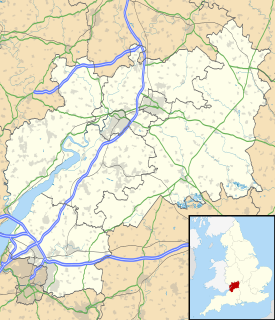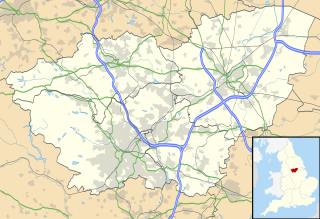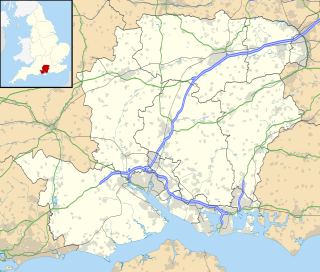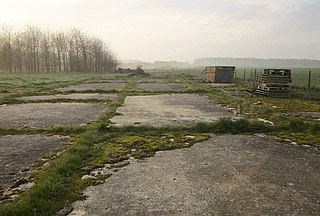
The former Royal Air Force Station Kenley, more commonly known as RAF Kenley was an airfield station of the Royal Flying Corps in the First World War and the RAF in the Second World War. It played a significant role during the Battle of Britain as one of the three RAF stations specifically tasked with the defence of London. It is located near Kenley, Surrey, England. The site remains in use with the Ministry of Defence, as Kenley Airfield.

Joint Helicopter Command Flying Station Aldergrove or more simply JHC FS Aldergrove is located 4.4 miles (7.1 km) south of Antrim, Northern Ireland and 18 miles (29 km) northwest of Belfast and adjoins Belfast International Airport. It is sometimes referred to simply as Aldergrove which is the name of a nearby village. The military flying units share the Aldergrove runways but have their own separate facilities and helipad.

Royal Air Force Wyton or more simply RAF Wyton is a Royal Air Force station near St. Ives, Cambridgeshire, England.

Royal Air Force Long Kesh or more simply RAF Long Kesh is a former Royal Air Force station at Maze, Lisburn, Northern Ireland.

Tain Air Weapons Range is a Ministry of Defence air weapons range on the Dornoch Firth near Tain in Scotland. Royal Air Force aircrews from RAF Lossiemouth are trained in air weaponry on the range, along with NATO aircrew.

Castle Bromwich Aerodrome was an early airfield, situated to the north of Castle Bromwich in the West Midlands of England. The site now falls within the City of Birmingham.

Royal Air Force Drem or RAF Drem is a former Royal Air Force station, just north of the village of Drem in East Lothian, Scotland. The motto of the station was Exiit Hinc Lumen which means "Light has departed from this place".

No. 66 Squadron was a Royal Flying Corps and eventually Royal Air Force aircraft squadron.

Royal Air Force Filton or more simply RAF Filton is a former Royal Flying Corps (RFC) and Royal Air Force (RAF) station located 5.0 miles (8.0 km) north of the city centre of Bristol, England.

Army Aviation Centre (AAC) Middle Wallop is a British Army airfield located near the Hampshire village of Middle Wallop, used for Army Air Corps training. The base hosts 2 (Training) Regiment AAC and 7 (Training) Regiment AAC under the umbrella of the Army Aviation Centre. 2 (Training) Regiment performs ground training; 7 (Training) Regiment trains aircrew on AAC aircraft after they complete basic training at RAF Shawbury.

Royal Air Force Detling or more simply RAF Detling is a former Royal Air Force station situated 600 feet above sea level, located near Detling, a village about three miles north-east of Maidstone, Kent.

Royal Air Force Acklington, simply known as RAF Acklington, is a former Royal Flying Corps and Royal Air Force station located 3.2 miles (5.1 km) south west of Amble, Northumberland and 8.8 miles (14.2 km) north east of Morpeth, Northumberland.

Royal Air Force Throwley or more simply RAF Throwley is a former Royal Air Force (RAF) installation located 1.2 miles (1.9 km) south of Throwley, Kent and 7 miles (11 km) north of Ashford, Kent. The installation was also used by the Royal Flying Corps was previously called Throwley Aerodrome before being taken over the RAF during April 1918 and renamed to its current name.

Royal Air Force Hawkinge or more simply RAF Hawkinge is a former Royal Air Force station located 2.2 miles (3.5 km) north of Folkestone, Kent and 7.1 miles (11.4 km) west of Dover, Kent, England. The airfield was used by both the Royal Flying Corps and the Royal Air Force during its lifetime and was involved during the Battle of Britain as well other important aerial battles during the Second World War.

Royal Air Force Catfoss or more simply RAF Catfoss is a former Royal Air Force station during the Second World War. It was located 4 miles (6.4 km) west of Hornsea, Yorkshire, England and 8 miles (13 km) north-east of Leconfield, Yorkshire, with the nearest village being Brandesburton.
No. 234 Squadron RAF had a long career within the RAF, being operational on flying boats in World War I and on fighter aircraft in World War II. After the war it remained a fighter unit till 1957. In its last incarnation the squadron was in turn Operational Training Unit (OTU), Tactical Weapon Unit (TWU) and part of No. 4 Flying Training School RAF until finally disbanded in 1994.

Royal Air Force Firbeck or more simply RAF Firbeck is a former Royal Air Force station located west of Firbeck, South Yorkshire, England.

RAF Worthy Down was a Royal Air Force station built in 1918, 3.5 miles (6 km) north of Winchester, Hampshire, England. After it was transferred to Royal Navy control in 1939 as RNAS Worthy Down, the airfield remained in use throughout the Second World War and then housed an engineering school from 1952. The airfield was in use until 1960. The site is now Worthy Down Camp.

Royal Air Force Bibury or more simply RAF Bibury is a former Royal Air Force satellite airfield located north east of Cirencester, Gloucestershire, England.

Leadenham Aerodrome was a Royal Flying Corps First World War airfield at Leadenham, Lincolnshire, England. It became RAF Leadenham in April 1918 until it closed in 1919.





















